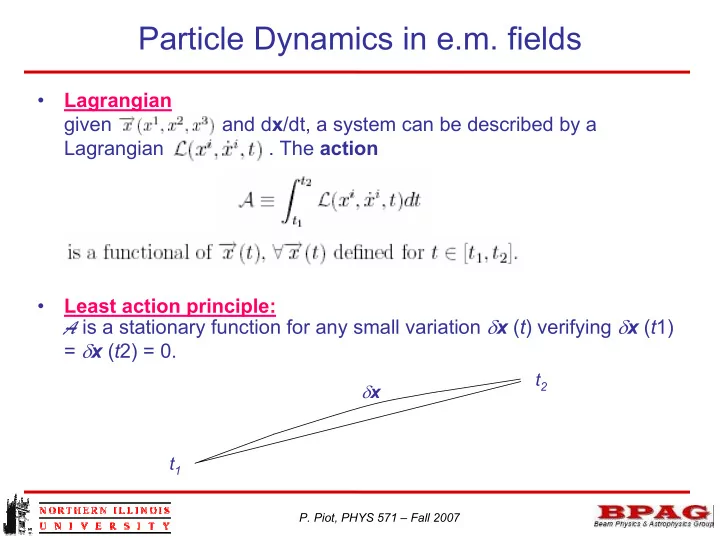

Particle Dynamics in e.m. fields • Lagrangian given and d x /dt, a system can be described by a Lagrangian . The action • Least action principle: A is a stationary function for any small variation δ x ( t ) verifying δ x ( t 1) = δ x ( t 2) = 0. t 2 δ x t 1 P. Piot, PHYS 571 – Fall 2007
Lagrangian: equation of motion • Once the Lagragian of a system is know the equation of motion are found from Euler-Lagrange equations: P. Piot, PHYS 571 – Fall 2007
Lagrangian: case of a free relativistic particle • The equation of motion must be the same in any inertial frame ⇒ A is a scalar invariant • A is a sum of infinitesimal displacement along a universe line x i (t) ⇒ L dt associated to an infinitesimal displacement must be a scalar invariant, that is: • We also must have the NR limit 2 • So and the relativistic Lagrangian is P. Piot, PHYS 571 – Fall 2007
Case of a relativistic particle in an e.m. field • Now we have Previous slide From interaction potential • The NR limit is: • Let’s try • So the total Lagrangian is P. Piot, PHYS 571 – Fall 2007
Checking equation of motion • Let’s check the Lagrangian derive gives the equation of motions: let’s compute: • Let’go… Equation of motion Equation of motion in CGS units! in CGS units! P. Piot, PHYS 571 – Fall 2007
Checking Least action principle • The Lagrangian is • …. • … P. Piot, PHYS 571 – Fall 2007
Checking Least action principle • … • So • And we recover the equation of motion P. Piot, PHYS 571 – Fall 2007
Canonical Conjugate and Hamiltonian • ... • And Hamilton’s equations are α ∂ dx H = α τ d dp α ∂ dp H = τ α d dx P. Piot, PHYS 571 – Fall 2007
Relativistic Hamiltonian • Consider the Levi-Civita tensor (rank 4) P. Piot, PHYS 571 – Fall 2007
Relativistic Hamiltonian • Consider the Levi-Civita tensor (rank 4) P. Piot, PHYS 571 – Fall 2007
Recommend
More recommend